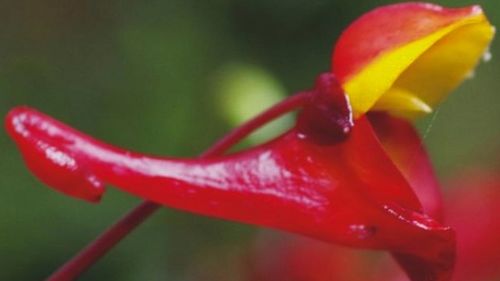The red flowers and green foliage of the endangered Impatiens frithii grows on the surface of small trees and low branches in the mountains of western Cameroon. This bird-pollinated plant shares its main pollinator, the sunbird Cyanomitra oritis, with four other Impatiens species. But unlike others in the same genus—which have these downward curving sepal spikes that contain nectar—the “nectar spur” of Impatiens frithii curves slightly upward (pictured above).
In an example of evolution’s elegant and unexpected solutions, researchers studying how floral structure affects pollination discovered that the flower twists itself when birds insert their bill, improving its chances of reproducing. The work was published in Current Biology this week.
One of the key innovations in the evolution of flowering plants is the specific placement of pollen on pollinators. Positioning their reproductive organs either in the lower or upper part of the flower enhances the plant’s “pollen economy,” but it’s also an architectural constraint: Flowers are only able to place pollen on the dorsal (backside) or ventral (belly-side) part of the pollinators’ bodies.
To understand how sunbirds could possibly sip from such an odd-looking spur, Michael Bartoš and Štěpán Janeček from the Academy of Sciences of the Czech Republic recorded more than 160 hours of video footage of bird visitors continuously for days. They found that the small modification significantly affects how pollen is placed on the birds' bodies—increasing the likelihood that the pollen will successfully land on the stigma of another flower of the same species.
With other Impatiens flowers, pollen could only be placed on birds' bellies or backs, but the unique twist of Impatiens frithii blossoms allows for the placement of pollen on the underside of the bird's head or bill.
 In the images to the right, you can see two types of pollen placement by Impatiens species. The sunbird foraging on Impatiens sakeriana (a) will only get pollen grains on the dorsal part of its head, unlike with the atypical spur curvature of the Impatiens frithii flower (b). When a sunbird inserts its bill into an Impatiens frithii flower that’s still in a normal position (c), the nectar spur inverts and fits the bird’s bill shape (d). The last two images were stills taken from this video.
In the images to the right, you can see two types of pollen placement by Impatiens species. The sunbird foraging on Impatiens sakeriana (a) will only get pollen grains on the dorsal part of its head, unlike with the atypical spur curvature of the Impatiens frithii flower (b). When a sunbird inserts its bill into an Impatiens frithii flower that’s still in a normal position (c), the nectar spur inverts and fits the bird’s bill shape (d). The last two images were stills taken from this video.
"When we saw the recordings from the cameras, we were really excited," Bartoš says in a news release. The twisting action is so quick, it was almost imperceptible. "We did not expect that the fit between flower spur and sunbird bill could be solved in such a simple way. Our enthusiasm was even greater when we realized the adaptive consequence for pollen placement."
The combination of that floral architecture with the resulting pollen placement likely reduces competition between Impatiens frithii and its close relatives. It also presents a reproductive barrier between species that could contribute to further speciation.
Images: Current Biology, Bartos et al.




